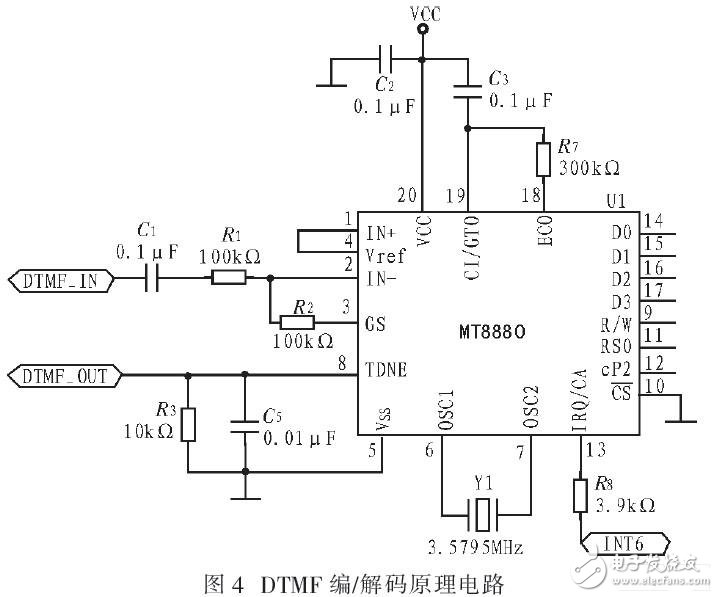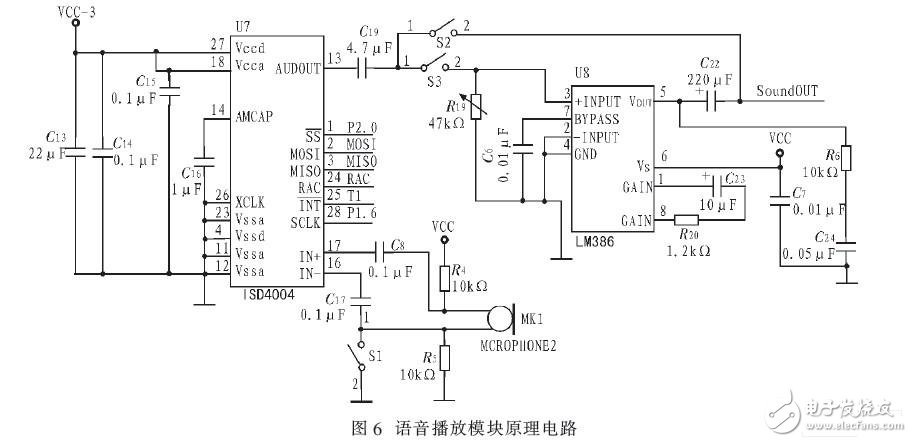Since the radio adopts a fully transparent transmission mode, as long as the frequency band is the same, the speech signal transmitted in the same frequency band can be received, so that it is impossible to accurately distinguish whether the signal is useful. Stations with voice encryption can avoid this situation, but in some areas or places where privacy is required. Therefore, here is a system based on the C8051F microcontroller that recognizes the identity of the station in DTMF encoding. The system is simple to use, and it can realize the identification of the radio identity by simply connecting to the extension port of the radio station without changing the original characteristics of the radio station. Even if the other party cracks the voice signal, the address can be used to distinguish the identity of the station. The system has certain application prospects in the field with high confidentiality requirements.
DTMF encoding/decoding
The DTMF encoder/decoder uses MT8880. The MT8880C is a single-chip DTMF signal transceiver with a call processing filter. The device features low-power, high-stability ISO-CMOS technology, a high-performance receiver with a variable gain internal amplifier, a transmitter with a pulse counter, and an accessible MT8880 internal The standard microprocessor interface for registers. Its internal register includes a status register, two data registers and two control registers. The circuit is shown in Figure 4.

The system uses a single-ended input mode, IN- is the op amp input, and R1 and R2 regulate the input signal gain. TDNE is an audio output for transmitting DTMF signals. OSCl is the clock/oscillator input, OSC2 is the clock output, and MT8880 is the 3.579 5 MHz operating clock. IRQ/CA is the interrupt request signal and the open-drain output. When there is DTMF signal input, IRQ/CA issues an interrupt request to C8051F020. D0~D3 are microcomputer data buses, compatible with TTL, output measured DTMF signals and input DTMF signals to be connected to the I/O interface of C8051F020. The 12-pin CP2 terminal is the system clock input. It cooperates with the R/W of the read/write control terminal to complete the read and write operations of the MT8880. The RS0 pin is the register selection and the TTL level is compatible. The address code can be composed of 0 to 9 and A to D. Due to the particularity of the application field of the system, the address code is encrypted. When the terminal acts as a transmitter, the DTMF encoding/decoding portion encrypts the address code of the terminal by a certain algorithm, and then modulates it into a DTMF signal, and then sends it to the station to facilitate identification by other stations in the network. When the terminal acts as a receiver, the DTMF encoding/decoding portion demodulates the received DTMF signal into a digital code, and then obtains an address code via a decryption algorithm. Considering that the impedance of the system may not match the impedance of the radio audio I/O interface, an audio transformer should be added between the two.

The voice storage player module uses ISD4004 from ISD. The voice device adopts the patented technology of multi-level direct analog memory (Chip Corder), the sound does not need to be A/D converted and compressed, and each sampled value is directly stored in the on-chip flash memory, thereby avoiding the quantization and compression of the general solid-state recording circuit. The resulting quantization noise and metallic sound. Figure 6 shows the principle circuit of voice playback. The voice input is directly connected to the ISD4004 pin IN+, IN- through the microphone (MIC) differential drive input. The voice output is amplified by the LM386 and connected to the voice output of the station. The system uses a keyed segment recording and playback mode. 10 different voices can be recorded through the recording button. Each recording corresponds to a button on the keyboard. According to the received voice signal, different voices can be played through 10 buttons, which is convenient and flexible to use.
Mobile phones and earphones have become necessities in our lives. How many people feel restless when they don`t have a mobile phone around. The mobile phone gives us a great sense of security to a certain extent, and its additional earphones also have such a function. . Wear headphones when you don`t want to talk; when you don`t want to listen to others, you wear headphones; when you don`t want to be harassed in an unfamiliar environment, you can play your favorite songs, be happy or sad, and enjoy your little universe most comfortable. There are now a variety of earphones on the market for people to choose from. From the original wired earphones to the current wireless Bluetooth earphones, they are more and more in line with people's requirements, and the sound quality and noise reduction are also constantly improving.
If you want to get a sports headset (sports scene) or a true wireless tws true wireless Bluetooth headset, what you expect from him is that it has the ability to withstand the test of different environments, wear it steadily, and have a long battery life, or it may be out of the street. Appearance, excellent sound quality, stable connection, friends who have certain requirements for sound quality and low requirements for noise reduction. You can take a look our earbuds.
Headphone 5.0 Handsfree,Cute Earphones,Mini Headphones,Ultra-Light Earbuds
Shenzhen Focras Technology Co.,Ltd , https://www.focras.com